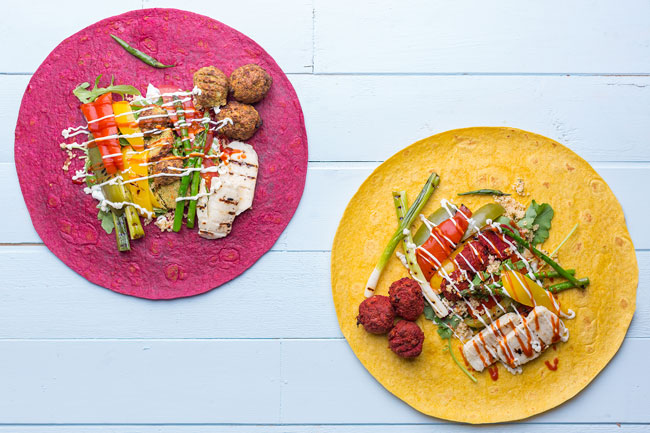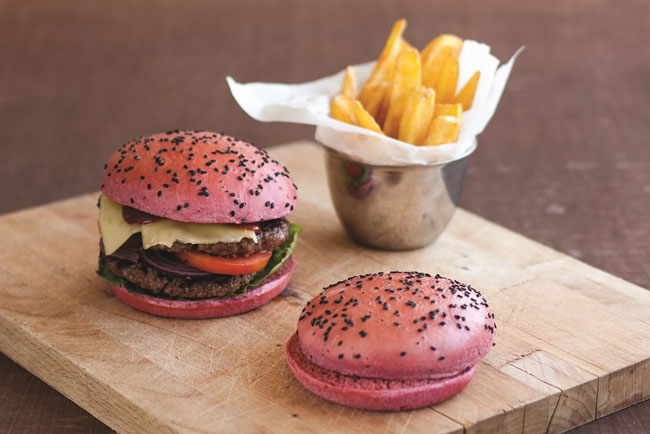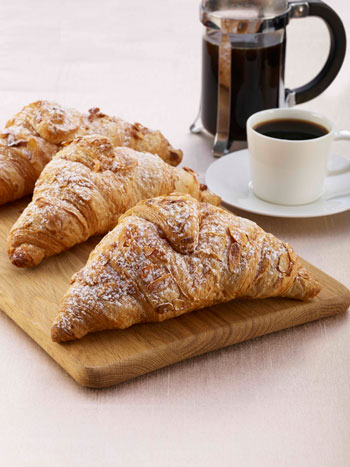Baked goods: Make or bake?
The profusion of pastries, cakes, desserts and breads to be found on social media highlights that aesthetically appealing bakery goods are the way forward for foodservice operators. But should they be made in-house from scratch or brought in frozen and baked to order?
Last month, the three-Michelin-starred Waterside Inn in Bray, Berkshire, hit the headlines thanks to a simple sign on the door: ‘no photos'. Chef Michel Roux was upset that diners were posting pictures of their food on social media rather than enjoying eating it.
If you check #watersideinnbray on Instagram, there are in fact only 128 posts, 12 of which are of the swans on the river beside the restaurant. However, bakery products are strongly represented. Croissants, afternoon tea cakes, biscuits, desserts and breads are all on display. Indeed, baked goods are at the heart of the social media #foodporn trend, with nearly six million Instagram posts tagged #bakery.
Popular TV shows, such as The Great British Bake Off and Bake Off: Crème de la Crème, along with hybrid products such as the scioche and croll, have brought bakery fully into the media glare, says Samantha Winsor, assistant brand manager at Lantmännen Unibake UK. Operators need to keep tabs on fashions, she adds, as an on-trend bakery offer on your menu will give you a better margin. âConsumers anticipate that these items will occupy higher price points and are therefore willing to pay more,â she says.
Those products, though, donât have to be made from scratch. Using frozen bakery items offers all the commercial benefits of fresh with minimal operational costs and without the inconvenience of finding space to store fresh ingredients. Frozen products also allow outlets the freedom to offer a range of quality bakery products with minimal labour requirements.
Premium breads
Gordon Lauder, managing director of frozen food distributor Central Foods, says: âOffering tempting, eye-catching and in-demand bread products can help caterers increase sales and boost profit margins.â He recommends bread products that look visually attractive and stand out on your snack counter display or on a menu or specials board. These products can tap into trends such as healthy eating and street food. âNew premium and artisan breads are being launched regularly â" it remains a fast-growing sector â" so itâs a good idea for caterers to review their bread options regularly, to help keep their offering fresh,â he says.
There is a sizeable appetite for sourdough breads and rolls in premium flavours. Flavoured wraps go down well too, especially those that please the eye as well as the taste buds.
Central Foods recently launched a KaterBake Beetroot Wrap and Pumpkin Wrap. Both are visually appealing and provide consumers with one of their recommended five a day, according to Lauder. Veganism, vegetarianism and flexitarianism are growing sectors, so it makes sense to offer menu items that appeal to these customers, he says, as well as those looking for gluten-free products. The gluten-free market remains key, and is particularly relevant to bakery products, with Coeliac UK estimating that there are more than 1.3 million (3% of British adults) follow a gluten-free diet.
The advantages of frozen are clear, Lauder says: âUsing frozen means a constant supply of âfreshâ stock. Being able to defrost and serve just what is required, for items like bread, is key to reducing waste, which helps cut costs.â
Visual appeal and taste are the consumer priorities when eating out, says Speciality Breads managing director Simon Cannell, especially with bread. âA point of difference â" something that stands out from the crowd â" is vital in the competitive foodservice market,â he says.
âWhen it comes to bread styles, flatbreads will continue to see strong interest due to their versatility and because chefs can use them like a blank canvas to create an array of dishes.â
The burger battle
Burgers will continue to take a large slice of pub and bar food sales, but nothing ever stands still, so chefs need to add some dazzle, adds Cannell. âThe burger sector is up there with the most innovative and creative sectors in foodservice,â he says. âThere is also a real trend for burgers with an ethnic twist and I expect this to continue, especially in pubs and bars, as the football World Cup is on the horizon in 2018.â Intense burger competition leaves operators needing to give consumers a compelling reason to visit their outlet, he says.
Paul Whitely, head of marketing at Aryzta Food Solutions, says: âIf operators get their burger offering right, the potential profits are evident. However, with the rise of Instagram and other social platforms, the importance of presentation and creating shareable, showstopping dishes has never been higher.â
Personalisation is another trend. It used to be just âmake your ownâ pizzas, but flexibility is now on offer right across breakfast, lunch and dinner. Cannell says: âThere is a big opportunity to introduce and push âmake your ownâ burgers, where consumers assemble their burger from the bread up. These types of menu create excitement from consumers at the table and often end up on social media. The customer pays a premium depending on the bread, toppings and the amount they want.â
Health will also remain a huge trend. Operators and chefs have to look at on-trend ingredients and cater for food allergies and the growing number of vegans and vegetarians.
Fresh or frozen?
On the fresh versus frozen debate, Cannell argues that most consumers would honestly not know that speciality breads come as a frozen product, as they are hand-finished. âIf you have the team, time and resources to make fresh bread in-house, great. But if not, our range is the next best solution.â
Stéphanie Brillouet, Délifrance UK marketing director, says baking from frozen offers the benefits of variety (as you can store a wider range), adaptability, and an opportunity to cut waste. âWith the right products, freshly baked from frozen can provide you with both quality and quantity with ease, and help you keep your breakfast, lunch and dinner offerings consistent,â she says.
Diners are becoming more adventurous and experimental in their choice of breads and menus need to reflect that, she adds. But with increased choice can come increased waste. To avoid wastage, offer a different alternative alongside the traditional loaves or pastries each day, week or month. That way, you can
see which variants are enjoyed the most and how much variety you really need, she suggests.
In terms of bread, sourdough loaves and inclusion loaves with cheese or olives are enjoying a rise in popularity. Sourdough has seen a 43% year-on-year growth, with cheese as an inclusion up 30%, says Brillouet. âInclusion loaves, in particular, provide a great opportunity, as the inclusion itself can be matched to different meals and menus, helping you get the most out of your bread,â she says. âAmong the other inclusions gaining popularity are fruits, nuts, Mediterranean flavours and spices.â
Away from bread, the viennoiserie market continues to grow, with indulgent chocolate pastries leading the way. Brillouet suggests offering some alternative flavours to the traditional butter croissant and pain au chocolat, such as chocolate-filled or multiseed croissants, and pains aux raisins.
Novelty value
Whitely says that millennials are âthe champions of new flavours and beautifully presented food â" and they can share the latter on social platforms such as Instagramâ. Rainbow bagels and unicorn frappuccinos recently took the social media world by storm and highlight just how much impact eye-catching creations can have, he says.
Aryzta has launched two Hiestandbranded burger buns â" in red with beetroot powder, and black, coloured with natural vegetable charcoal â" to help operators premiumise their burger offering and boost the all-important Instagram factor.
âOur new buns are exactly what outlets need to add a little something extra to impress customers and to ensure their menu stays ahead of the competition,â Whitely says. âWhatâs more, theyâre frozen, so chefs donât have to worry about wastage and any potential profit losses.â
Marie-Emmanuelle Chessé, international development project manager at Tipiak, agrees. âCreating Instagram-worthy bakes that tempt customers is becoming increasingly important to boost profit margins,â she says.
Presentation, though, can be a challenge in terms of bakery products, especially for operators that lack the time or experience in the team. Tipiakâs range of gluten-free macarons and mini Pop Eclairs can help operators easily meet demand, benefiting from higher profits at the same time, says Chessé.
Offering a variety of special dietary products is becoming a priority, as gluten- free accounts for 60% of the free-from category and increased 36% between 2015 and 2016. âCustomers will love these French desserts, and given their popularity on social media, they could help operators expand their base even further and reach new customers,â Chessé says.
Make it yourself
While for many, the solution is to buy in products, there is much to be said for baking in-house, says Michael Eyre, culinary director at Jestic Foodservice Equipment. He points out that the rise in artisan bakeries, farm shops and delis, along with consumer demand for fully traceable food and ingredients, has boosted the craft bakery market in the UK over recent years. âThis drive for quality has led sectors of the foodservice market to look at ways in which prepared baked goods can be served to customers, and to invest in the equipment and technology to bake in-house,â he says.
When making fresh bread in-house, the chefâs skill and knowledge, and the type and style of equipment used, are key, he adds. Professional-standard bakery ovens give a consistent finish and excellent texture. Eyre says: âWith the delicious taste and wonderful aroma of freshly baked bread, customers will be drawn into a catering establishment. Whatâs more, by producing in-house, a business can be perceived to be taking great care and attention over the food offering, something that will stretch far beyond the fresh bread alone. For those looking to portray themselves as an artisan producer, a range of homemade baked goods is essential.â
A generation of foodies is becoming increasingly conscious and discerning about its food choices, and a varied offering helps to appeal to a wider audience, says Owen Davies, category manager for dairy and pâtisserie at speciality distributor Harvey & Brockless.
âWe tend to find that many of our customers try to focus on producing exceptional classics, starting by using the best essential ingredients that they can afford,â he says.
And Mark Rigby, executive chef at Premier Foods, says it is far more cost- and time-effective to prepare baked goods using flour-based mixes. The fresh bread and baked goods can be offered for sale on a bakery counter, as well as in the restaurant.
For those not ready to take the plunge of baking from scratch, solutions such as PanâArtisanâs may help. Director of sales Stuart Jackson says PanâArtisan has a frozen 5% Sourdough Dough Ball that can be used as a pizza base, sandwich carrier or meal accompaniment. This customisability enables operators to make a bespoke product.
If youâre going to make it in-house, you need to make it really well, otherwise buy it in from an expert. Remember: nearly all your customers will come to dine armed with a phone and a camera.
So the only question that remains is whether the Waterside Inn will relent on its customer photo ban following the press furore. A firm no comment seems to be as much as you will get in the way of an answer there.





















